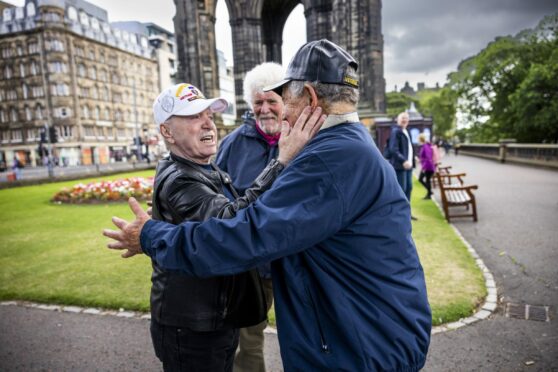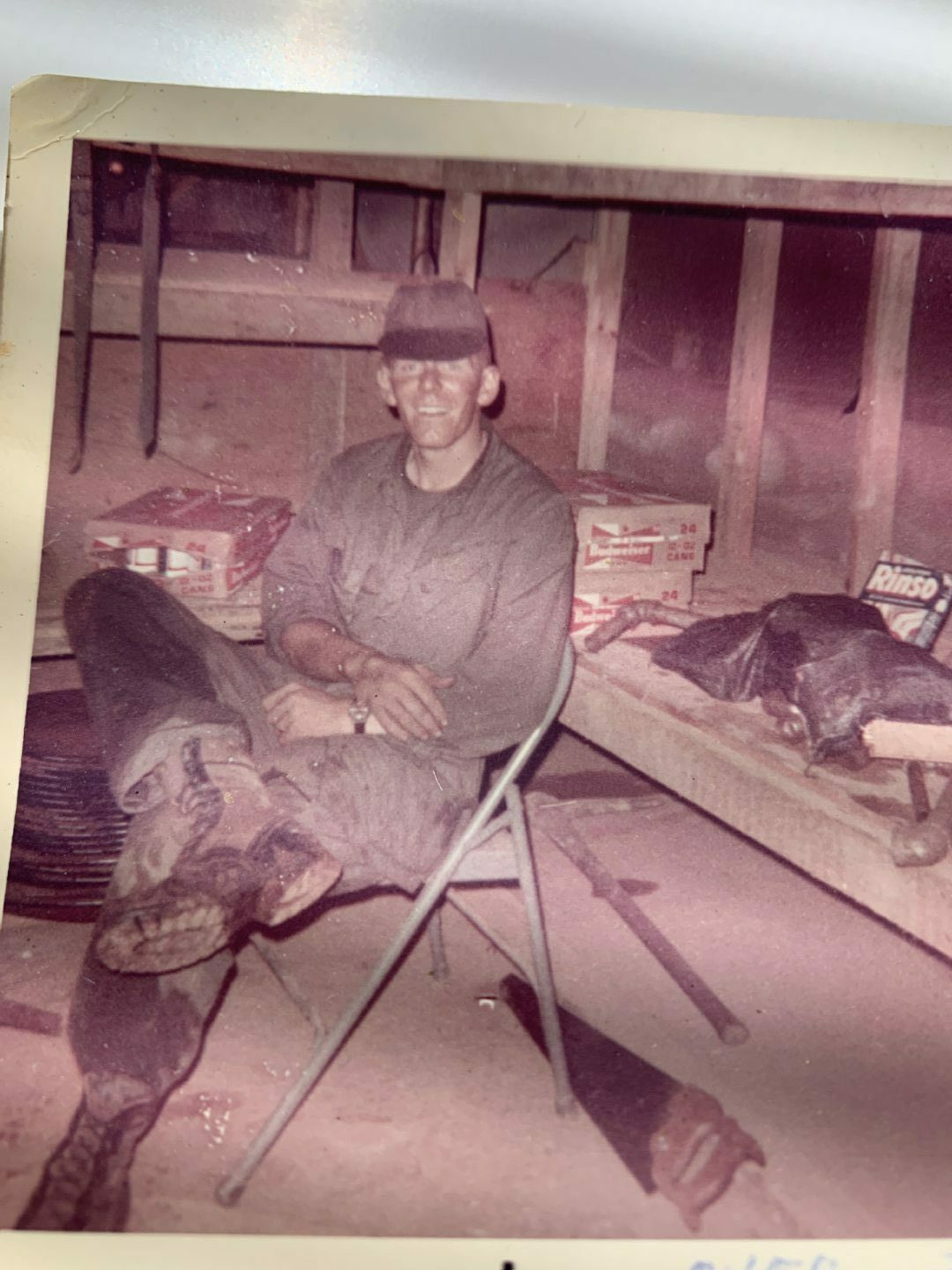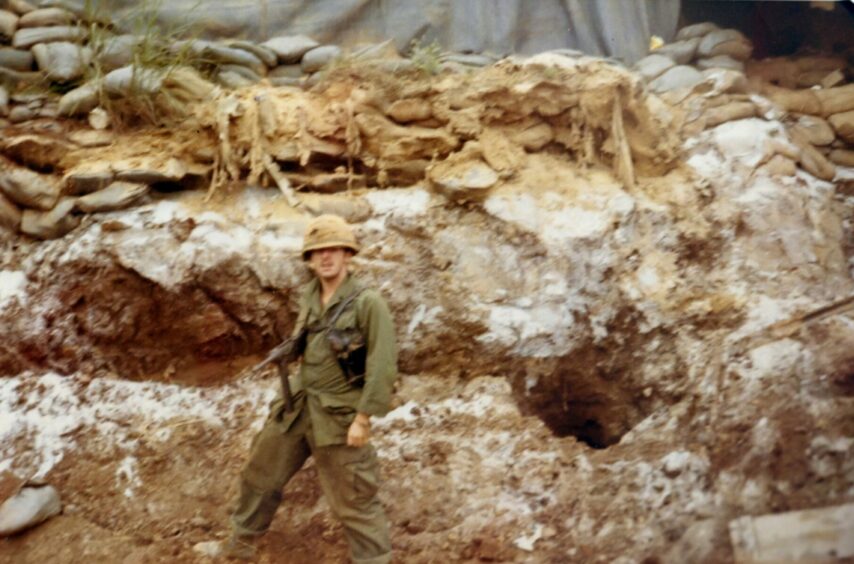
To anyone watching, it would seem like nothing more than three old pals on an outing in the capital.
The broad smiles, vigorous handshakes and warm backslaps of the trio of 70-somethings in Princes Street Gardens give no indication of their shared and rare service – Scots who fought in the Vietnam War.
Incredibly, despite serving at the same time, and sometimes only a few miles apart, they had never met until Monday. The Fourth of July.
Last month The Sunday Post told how teenage runaway John Keaveney, who left Scotland for America and then to Vietnam, was coming home.
In Southeast Asia he was one of an elite band of Tunnel Rats, pursuing Viet Cong insurgents into subterranean labyrinths stretching for miles, danger and death lurking just beyond a torch beam. We told how, at 72, Keaveney, who plunged into addiction and prison after leaving the Army but turned his life around with charity work helping other veterans, was returning to the country of his birth.
His story touched former artillery gunner, Brian McAngus, 77, from Fraserburgh, and infantryman Brian Thomson, 78, of Dunfermline, who also served in Vietnam’s Quang Tri region along the DMZ – the wartime dividing line between North and South Vietnam. They contacted Keaveney via The Sunday Post, and after the Tunnel Rat finally touched down on home soil, took the opportunity to meet him.
As the trio talked of bravery below ground which earned Keaveney the US Bronze Star for Valour and the then-Republic of Vietnam Gallantry Cross and swapped old photos and documents from their time there, dad-of-three Keaveney said: “It is wonderful. What are the chances of meeting two Scottish veterans of the war in Vietnam here at home in Scotland; soldiers who were so close to where I was in Vietnam, and especially on such a milestone in the history of what Scottish veterans did for America?
“Scots fought in the War of Independence that led to the signing of the Declaration of Independence on the Fourth of July 1776. And here we are, on the Fourth of July! It must be destiny.”
McAngus, also a former merchant mariner who went to the same sea school as Keaveney – Vindicatrix, at Sharpness in Gloucestershire – said: “We were both ‘Vindi Boys’, we went to sea, ended up living with family in America and fighting in Vietnam. The coincidence is amazing despite the fact we never met before. It means a great deal to be able to finally shake hands.”
Thomson, who was attached to the 101st Airborne Division, or Screaming Eagles, a light infantry division specialising in air assault, was the only one among them married when he got the draft. Thomson, who later joined the Los Angeles Police Department before retiring and returning home to Scotland, added: “It’s good to see they made it back too and are still fit and healthy.”
It almost was not the case for Keaveney who says his war began after leaving Vietnam and facing the controversy and criticism that surrounded the conflict. The 10-year war saw South Vietnam fall to the communist North in 1975.
Suffering from Post Traumatic Stress Syndrome and angered by “the terrible treatment” of many veterans, he fell into a life of homelessness and drug and alcohol-induced violent crime. But he turned his life around and in 2011 he was awarded the Presidential Citizens Medal – America’s second-highest civilian honour – by Barack Obama for his work breathing life into the New Directions charity that went on to help thousands of struggling veterans find homes, overcome addiction, get into education and work, and rebuild their broken families.
On Monday, with his new-found former comrades, Keaveney led a pilgrimage to Edinburgh’s Old Calton Cemetery and the 1893 memorial statue of 16th US President Abraham Lincoln that commemorates Scots who fought on behalf of the Union in the American Civil War and for an end to slavery. At its foot are the words: “To preserve the jewel of liberty in the framework of freedom.”
He said: “After the war in Vietnam veterans were not really welcome so a lot of us hid the fact that we served there. But we put our lives on the line for all the right reasons, like the Scots that this statue commemorates. We were there to fight for freedom and democracy. And of that we must be proud.”
‘I couldn’t have lived with myself if I had not gone on tour’
Brian Thomson emigrated to America knowing he might be called up to fight in Vietnam, although he thought the chances were slim.
Thomson, now 78, was a 24-year-old man whose wife Margaret, now 74, had family in the country. But he was told those who were drafted were mostly single with an average age of 19.
The former soldier, who grew up in Fife and now lives in Dunfermline, said: “American law stated that after six months in country you had to register with the draft. I waited until the very last day before registering but within six months I was in basic army training at Ford Ord in California. It turns out that Brian McAngus and I were there at the same time. That was in 1968. On January 13, 1969, I left for Vietnam.
“I remember getting our orders like it was yesterday. We had been out on manoeuvres and it was chucking down with rain. There were a couple of hundred of us and almost all were sent to Vietnam. I had a choice. I could have gone home but I am old-fashioned. It was ‘death before dishonour’. And even although some people were saying, ‘don’t go, go home’ I don’t think I could have lived with myself if I had.”
Thomson, who with his wife has a daughter Melissa, now 49, shipped out to the 101st Airborne Division – the Screaming Eagles – at Camp Evans, north-west of Hue in central Vietnam. From there he joined a security team protecting a general but as a former coach maker skilled in electronics, he helped set up firebases – like Berchtesgaden.
He said: “One night I was away from Firebase Berchtesgaden and getting supplies when it was overrun by the enemy. Of the 35 guys who were there, we lost 14. We secured the base. If I had been there I might not be alive now. It is the luck of the draw. You didn’t have time to be scared. You just concentrated on making it through.”
Thomson, who was given US citizenship during R&R in Hawaii, returned to the 101st at Mai Loc 101st south of the demilitarized zone. He said: “I was probably within a couple of miles of John and Brian but we never met.”
He served the obligatory full year in Vietnam. “You could have extended for 40 days,” said Thomson, “but I figured if they didn’t get me in 365 I wasn’t going to give them any more opportunity.”
Thomson was awarded the Bronze Star for Meritorious Achievement and the Army Commendation Medal.
He later joined Los Angeles police working in traffic, narcotics, vice, and as a detective. He retired in 1991 and returned to Scotland, working with young people with disabilities for the council. Now retired, he said: “It was always our plan to come home to Scotland.”
The tunnel rat
At 5ft 4in and weighing just eight and a half stone, John Keaveney was chosen as one of only 700 elite Tunnel Rats out of an entire fighting force of 2.7 million.
The volunteer went into the tunnels to flush out the enemy armed with only a 45 pistol, a knife and a flashlight. Often locked in hand-to-hand combat, he still has nightmares.
His war service took a terrible toll, as, in the years ahead, he endured post-traumatic stress disorder and what he believes is the legacy of toxic herbicide Agent Orange, which was used by the Americans to destroy forest and crops.
Today, Keaveney, 72, who was recently tested for cancer and is so far free of the disease, says dioxin was, however, detected in his kidneys. “Dioxin is a foundation to Agent Orange and it’s a poison,” he said. “It is killing Vietnam veterans. They sprayed it on the jungle and it went into the water. We drank the water.”
The veteran – whose oldest child John, 47, is a top chef at Caesar’s Palace in Las Vegas – is in Edinburgh with his second wife Raida, 50, and their children Jaida, 29, and Dillon, 19, to make preparations for a permanent return in August. He said: “I am an old soldier coming home to die.”
The gun bunny
Like Keaveney and Thomson, Brian McAngus, 77, had relatives in the US. McAngus, a widower from Fraserburgh in Aberdeenshire, revealed he too was influenced by a grandfather who fought in the Great War, and like Keaveney joined the Merchant Navy.
He decided to settle in America with his older brother after the death of their father and had to register for the draft before he could become a citizen. He was called up on November 26, 1969, his 24th birthday. He said: “I was going to live in the US and I thought I could do my bit. I was proud to be in the army. My grandfather fought in the First World War.”
After training at Ford Ord in California and Fort Sill in Oklahoma, he joined the 2nd Battalion 94th Artillery. He served out of firebases near the demilitarized zone largely as a “Gun Bunny”, handling shells (some weighing 203lbs), operating an 8in gun and living in bunkers. McAngus has never before spoken publicly about his tour in Vietnam that earned him the Medal of Commendation for Meritorious Service.
The old soldier, who returned to Scotland after the war and worked on oil industry supply boats in the North Sea, said: “I was there to support other troops. But we were often hit with mortars and rocket fire.
“The attacks usually only lasted a few minutes before the US helicopter gunships would come out and fire at them. On one occasion, our mess hall was hit and we lost men.”
For the last six months of his tour McAngus was in the ammunition section, on the truck carrying shells from the main base to the fire base.
An eight-mile journey through jungle at constant risk of ambush, he was in charge of the rifle and protecting the driver and cargo. He said: “I can’t say I was scared. It was more like adrenalin.”

Enjoy the convenience of having The Sunday Post delivered as a digital ePaper straight to your smartphone, tablet or computer.
Subscribe for only £5.49 a month and enjoy all the benefits of the printed paper as a digital replica.
Subscribe © Jamie Williamson
© Jamie Williamson © SYSTEM
© SYSTEM © David Becker
© David Becker